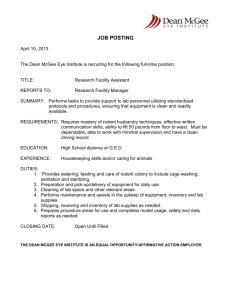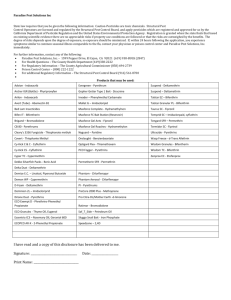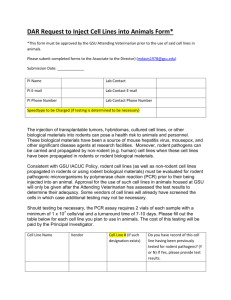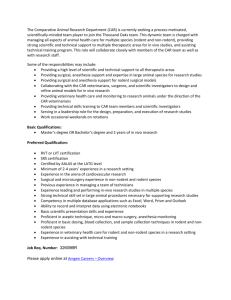Standard Operating Guideline – Pest/Rodent Control
advertisement
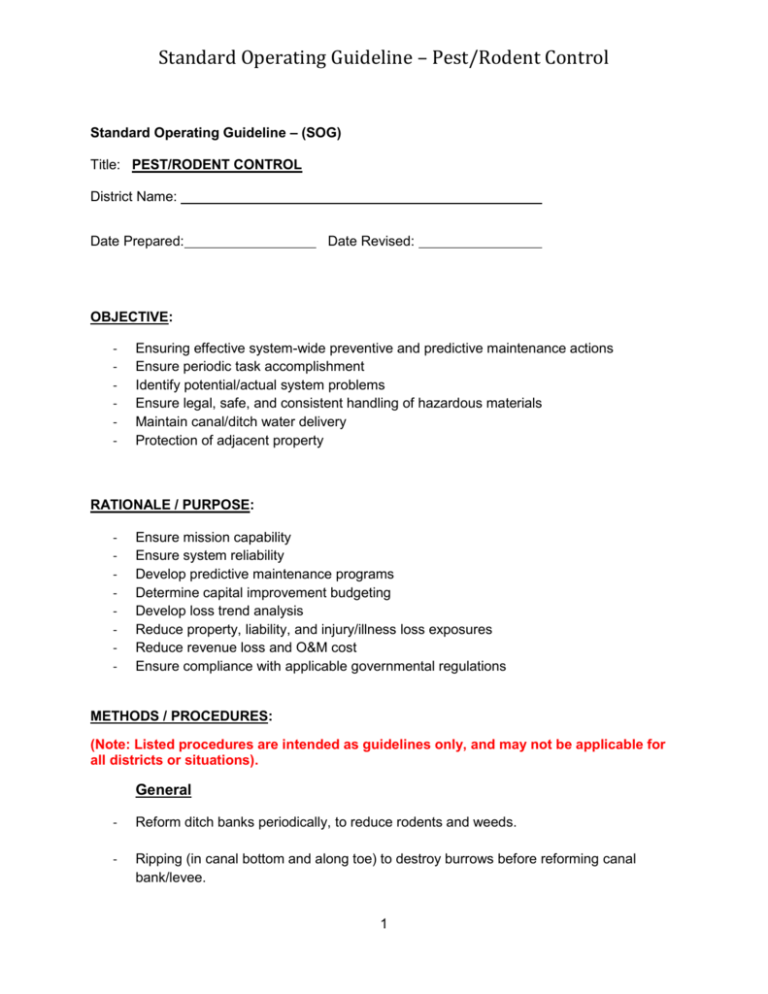
Standard Operating Guideline – Pest/Rodent Control Standard Operating Guideline – (SOG) Title: PEST/RODENT CONTROL District Name: Date Prepared: Date Revised: OBJECTIVE: - Ensuring effective system-wide preventive and predictive maintenance actions Ensure periodic task accomplishment Identify potential/actual system problems Ensure legal, safe, and consistent handling of hazardous materials Maintain canal/ditch water delivery Protection of adjacent property RATIONALE / PURPOSE: - Ensure mission capability Ensure system reliability Develop predictive maintenance programs Determine capital improvement budgeting Develop loss trend analysis Reduce property, liability, and injury/illness loss exposures Reduce revenue loss and O&M cost Ensure compliance with applicable governmental regulations METHODS / PROCEDURES: (Note: Listed procedures are intended as guidelines only, and may not be applicable for all districts or situations). General - Reform ditch banks periodically, to reduce rodents and weeds. - Ripping (in canal bottom and along toe) to destroy burrows before reforming canal bank/levee. 1 Standard Operating Guideline – Pest/Rodent Control - Control weeds to allow visual inspection of canal banks/levees.When mowing is used as an alternative to herbicide use, inspect immediately after mowing to observe rodent activity. - Elimination of fur bearing or game animals may require debridation permits from Fish and Game (including beavers). (See Trapping Procedures Section). - Muskrats generally do not require debridation permits for eradication (contact local Fish and Game office for questions or details). - All pest control applicators should undergo “sensitivity training” to be able to recognize protected species (Fish and Game). - Only persons properly trained or under direction of certified applicators (QAC) may perform pest control activities including gassing, gopher bombs, and poisoning by various means. - Rodent barriers prevent some rodent activity where other methods are not effective. (Trench, then fill with concrete, adjacent to ditch bank). - Owl boxes can be a cheap and effective option for rodent control. They are nonhazardous to personnel and environment. Inspection - Inspect banks and levees regularly for rodent activity. - Do complete inspection at end of season, and set priorities for maintenance before next water season. - Animal burrows, once identified, should be excavated, inspected, and backfilled with compacted soil similar in material to the bank or levee. - Boils should be investigated as a burrow. Eradication Poison/Bait - Use of poisons and other hazardous materials shall be documented/logged. Fill out Weed & Pest Report – mile number and amount used. 2 Standard Operating Guideline – Pest/Rodent Control - Feed only active holes. This poison is expensive and there is no need to waste it. Bait station entrance cannot be larger than 3-inches in diameter. - Poison grain-timing is critical. Follow recommended procedures for material. Must be the only source of food to be effective. - Diphacinone Rodent bait works extremely well in rural/remote areas. - Diphacinone Rodent bait works extremely well in rural/remote areas. - When putting out station in early spring take pad, pencil, record mile numbers, and number of stations. o Example: Mi. 120.05 o/p side to 127.68 = 13 stations. - Put in 3 - 4 cups when setting out station and should be checked every other day. o If it runs out of bait for three days you will have to start over again. o Cover fill tube with cup to keep out rain. o Clean up any spill, put in bucket, or bury it. - Please weigh any partial bucket and record on top of bucket with flow pen how much is left for inventory purpose. Know the weight of a full bucket. - Keep bait stations full. Must eat 3 - 4 days to be effective. - When bringing in bait stations in the fall, they should be cleaned out and old bait put in container and disposed of in approved manner. - Use proper bait for application, broadcast vs. bait station. - Pest baiting must occur for a period of time to allow necessary feeding. Springtime works best. Rodents are hungry after birthing, there is little forage available, and can also kill young. - Broadcasting bait sometimes works better, but some crops do not allow this practice. - Use a seed spreader to broadcast poison bait (for scavenging squirrels). 3 Standard Operating Guideline – Pest/Rodent Control - Broadcast bait 20-feet from hole. Gassing/Bombs - Use phosgene gas in the winter (when moisture present). - Use smoke bombs year round. - Do not use smoke bombs in an area if there is a potential for fire danger. Trapping - When beaver activity is observed, the beaver should be removed (trapped), and the dam and blockages removed. A debridation permit will likely be required. Notify your local Fish and Game office and follow instructions as given for obtaining a permit, trapping, or other means of eradication. - Poisoning of ground squirrels where endangered species are present, (such as Kangaroo Rats) may be prohibited in some areas. Contact your local Fish and Game office for more details. INCIDENT RESPONSE: See Canal Failure Response SOG Preparation - A standby/on call procedure needs to be established to respond to emergencies. - Equipment must be available to respond to and repair canal/levee failures. - Proper fill material must be available to repair crews. SAFETY CONSIDERATIONS: An effective maintenance program can help to prevent damage to property, the environment, and injury to employees and the public, and will help to: - Preclude system and equipment damage Preclude property and environmental damage Facilitate operations and maintenance personnel safety Identification of safe work practices among employees should include: - Hazardous material handling 4 Standard Operating Guideline – Pest/Rodent Control o o o o - First Aid/CPR procedures and supplies Poison Control Procedures Eyewash and decontamination supplies Spill and containment equipment Fall protection Read MSDS before starting job. Have a copy in vehicle for emergency. Follow established safe handling and operations procedures (as specified on MSDS and informational sheet). Wear all safety equipment (as specified on MSDS and informational sheet). Use rubber gloves when handling bait, coveralls, dust cover, measuring cup and funnel. Keep all poison in a closed container Before smoking or eating, wash hands with detergent and water Only trained personnel shall handle hazardous materials. Watch your step on uneven ground Watch out for snakes Have contact information and communication means available onsite COST/ BENEFIT: - Reduce revenue losses Avoid costly liability, property, and injury/illness losses Preventive maintenance and loss trend data would reduce facility, equipment, system failures. INSPECTION FORMS / CHECKLISTS / DOCUMENTATION: - Training Log Daily Weed Control Report Pesticide Safety Training Record REFERENCES: - U.S. Army Corps of Engineers, Levee Owner’s Manual for Non Federal Flood Control Works, March 2006, Section 2.6. www.usace.army.mil/Emergency/Pages/home.aspx University of California, “Pesticide Safety and Application Regulations.” UC Integrated Pest Management Website: www.IPM.ucdavis.edu. California Department of Pesticide Regulations website: www.cdpr.ca.gov 5

